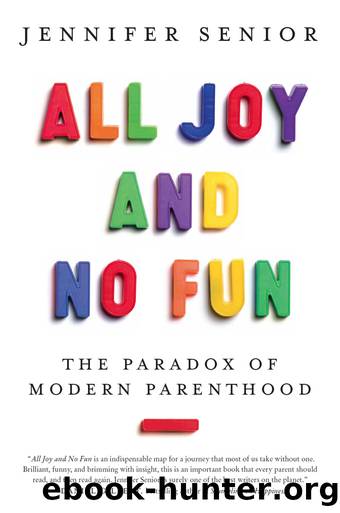All Joy and No Fun by Jennifer Senior

Author:Jennifer Senior
Language: eng
Format: epub
Publisher: HarperCollins
Published: 2013-12-09T16:00:00+00:00
THE SENTIMENTALIZATION OF CHILDHOOD has produced a great many paradoxes. The most curious, however, may be that children have acquired more and more stuff the more useless they have become. Until the late nineteenth century, when kids were still making vital contributions to the family economy, they didnât have toys as we know them. They played with found and household objects (sticks, pots, brooms). In his book Children at Play, the scholar Howard Chudacoff writes, âSome historians even maintain that before the modern era, the most common form of childrenâs play occurred not with toys but with other childrenâsiblings, cousins, and peers.â
But by 1931, kids had enough gear for the Hoover White House to declare that they deserved a room of their own. Children, said conferees on a panel on childâs health, needed âa place where they may play or work without interference from or conflict with the activities of the adult members of the family.â The idea of the modern playroom was born, by executive decree.
In the years directly following World War IIâthe time when modern childhood began in earnestâthe toy boom began in earnest too. In 1940, toy sales were a modest $84 million; by 1960, they had reached $1.25 billion. Many classic childrenâs toys were invented during this era, including Silly Putty (1950) and Mr. Potato Head (1952). And the pickings back then were paltry compared to today, when playrooms as well stocked as Emilyâs are increasingly common. In Parenting, Inc. (2008), Pamela Paul writes that toy industry sales âfor babies between birth and age two aloneâ were over $700 million annually. According to the Toy Industry Association, domestic sales of kidsâ toys were $21.2 billion in 2011, a figure that didnât include video games.
Such oceans of plenty have had unintended consequences. In Huckâs Raft, Steven Mintz notes that toys before the twentieth century were primarily social in natureâjump ropes, marbles, kites, balls. âModern manufactured toys,â on the other hand, âimplied a solitariness that was not a part of childhood before the twentieth century.â Heâs thinking of Crayons, for instance, introduced in 1903. Or Tinker Toys (1914), Lincoln Logs (1916), or Legos (1932).
More generally, writes Mintz, âone defining feature of young peopleâs lives today is that they spend more time alone than their predecessors.â They grow up in smaller families (22 percent of American children today are only children). They are more likely to have their own rooms than children in generations past, and to live in larger homes, which means the very architecture of their lives conspires against socializing with other family members. They also live in a nation of suburbs and exurbs, where neighbors and friends live farther away.
Isolation results in a lot of extra work for parents. Their children recruit them as playmates, as Emily does Carol. They are prodded for rides hither and yon. And parents oblige, worrying that their children will suffer from loneliness if they donât. This is yet another reason why mothers and fathers schedule so many after-school activities for their children.
Download
This site does not store any files on its server. We only index and link to content provided by other sites. Please contact the content providers to delete copyright contents if any and email us, we'll remove relevant links or contents immediately.
Nudge - Improving Decisions about Health, Wealth, and Happiness by Thaler Sunstein(7622)
iGen by Jean M. Twenge(5367)
The Fire Next Time by James Baldwin(5251)
Adulting by Kelly Williams Brown(4489)
The Hacking of the American Mind by Robert H. Lustig(4319)
The Sports Rules Book by Human Kinetics(4299)
The Ethical Slut by Janet W. Hardy(4178)
Captivate by Vanessa Van Edwards(3796)
Mummy Knew by Lisa James(3637)
In a Sunburned Country by Bill Bryson(3486)
The Worm at the Core by Sheldon Solomon(3437)
Ants Among Elephants by Sujatha Gidla(3417)
The 48 laws of power by Robert Greene & Joost Elffers(3031)
Suicide: A Study in Sociology by Emile Durkheim(2975)
The Slow Fix: Solve Problems, Work Smarter, and Live Better In a World Addicted to Speed by Carl Honore(2950)
Humans of New York by Brandon Stanton(2835)
The Tipping Point by Malcolm Gladwell(2829)
Handbook of Forensic Sociology and Psychology by Stephen J. Morewitz & Mark L. Goldstein(2660)
The Happy Hooker by Xaviera Hollander(2655)
